BSBPMG505A: Project Quality Management Plan for Blue Mountains TAFE
VerifiedAdded on 2022/08/18
|22
|5342
|167
Project
AI Summary
This project quality management plan (QMP) is designed to ensure the highest quality standards for the Western Sydney Institute of TAFE's new college for Beauty Therapy and Complementary Health at the Blue Mountains College. The plan details project specifics, including architectural, civil, hydraulic, and mechanical works, ensuring compliance with ISO, AS/NZS, and Australian construction standards. It outlines the project team structure, quality policies adhering to ISO 9001:2008, and a comprehensive quality procedure register. The register covers various aspects such as health and safety, customer focus, environmental management, human resources, financial management, asset management, project management, procurement, documentation, verification procedures, and continuous improvements. The plan also includes an audit schedule and detailed descriptions of each quality procedure, ensuring a systematic approach to project execution and quality control. The project involves a bid submission that includes a detailed plan for managing project quality to ensure project success. The plan also contains details about the project team and its structure. It also mentions an audit schedule.

WSI Blue Mountains TAFE Project Quality Management Plan
Author1
1Author Affiliation
Author Email :
Author1
1Author Affiliation
Author Email :
Paraphrase This Document
Need a fresh take? Get an instant paraphrase of this document with our AI Paraphraser
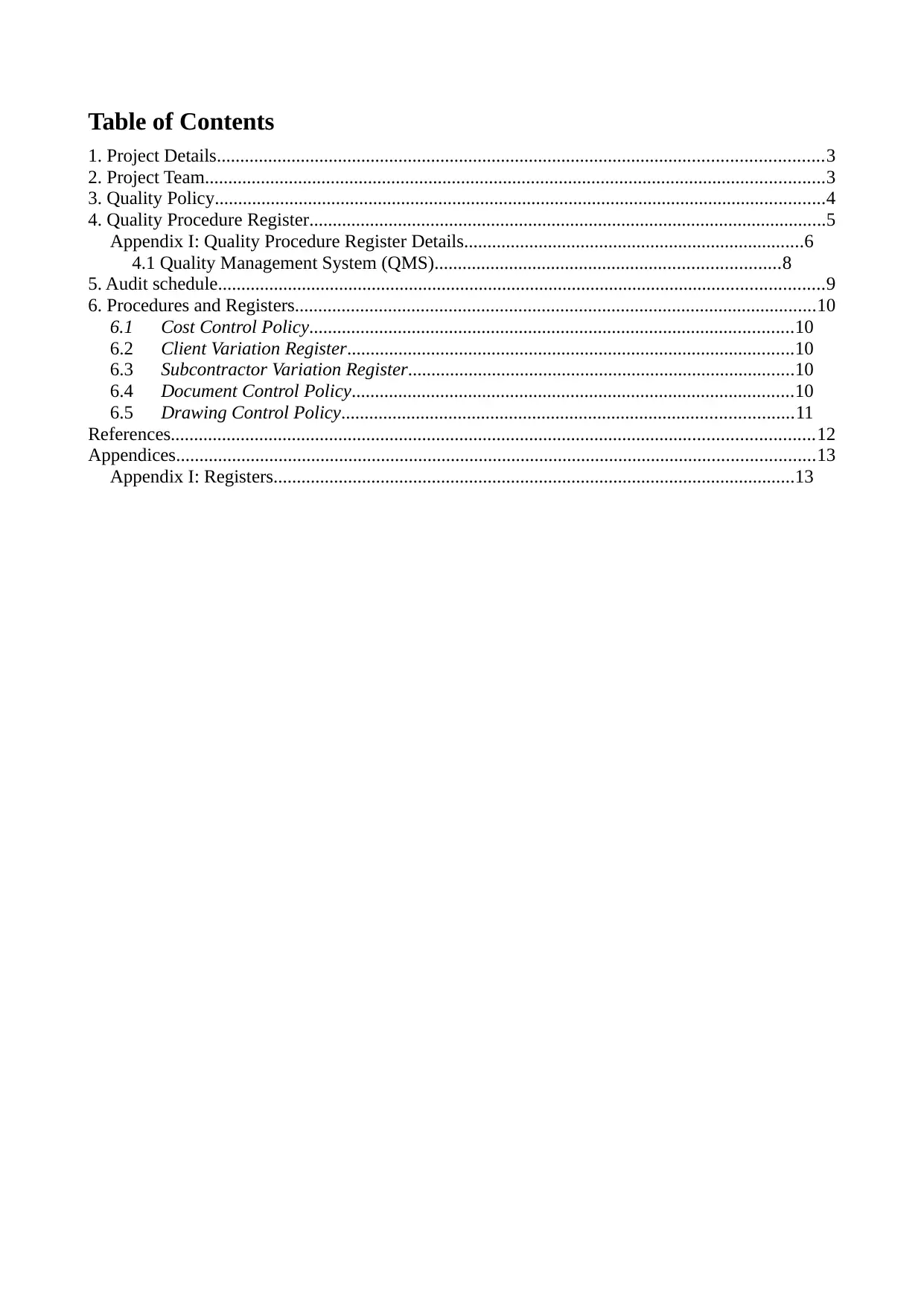
Table of Contents
1. Project Details..................................................................................................................................3
2. Project Team.....................................................................................................................................3
3. Quality Policy...................................................................................................................................4
4. Quality Procedure Register...............................................................................................................5
Appendix I: Quality Procedure Register Details.........................................................................6
4.1 Quality Management System (QMS)..........................................................................8
5. Audit schedule..................................................................................................................................9
6. Procedures and Registers................................................................................................................10
6.1 Cost Control Policy........................................................................................................10
6.2 Client Variation Register................................................................................................10
6.3 Subcontractor Variation Register...................................................................................10
6.4 Document Control Policy...............................................................................................10
6.5 Drawing Control Policy.................................................................................................11
References..........................................................................................................................................12
Appendices.........................................................................................................................................13
Appendix I: Registers................................................................................................................13
1. Project Details..................................................................................................................................3
2. Project Team.....................................................................................................................................3
3. Quality Policy...................................................................................................................................4
4. Quality Procedure Register...............................................................................................................5
Appendix I: Quality Procedure Register Details.........................................................................6
4.1 Quality Management System (QMS)..........................................................................8
5. Audit schedule..................................................................................................................................9
6. Procedures and Registers................................................................................................................10
6.1 Cost Control Policy........................................................................................................10
6.2 Client Variation Register................................................................................................10
6.3 Subcontractor Variation Register...................................................................................10
6.4 Document Control Policy...............................................................................................10
6.5 Drawing Control Policy.................................................................................................11
References..........................................................................................................................................12
Appendices.........................................................................................................................................13
Appendix I: Registers................................................................................................................13

1. Project Details
This quality management plan (QMP) is intended to ensure the highest quality standards in the
Western Sydney Institute of TAFE which aims at setting up a new college for Beauty Therapy as
well as Complementary Health at the Blue Mountains College. The project is extensive and
appreciably complex as in entails the construction of a new campus. The project entails architectural
designs and drawings and civil engineering works. The project will also entail the development of
hydraulic services, landscaping, mechanical works, and civil works entailing the construction of
streets and their attendant amenities, including roads and sidewalks. Such a complex project will
entail ensuring the finished product meets industry standards that include ISO (International
Organization for Standardization), AS/NZS quality management systems, and the relevant national
and local construction and engineering works standards for Australia. To undertake the project, a
bid must be placed which includes a detailed plan for managing project quality to ensure project
success; this is an important feature that has a huge bearing on winning the project.
This quality management plan (QMP) is intended to ensure the highest quality standards in the
Western Sydney Institute of TAFE which aims at setting up a new college for Beauty Therapy as
well as Complementary Health at the Blue Mountains College. The project is extensive and
appreciably complex as in entails the construction of a new campus. The project entails architectural
designs and drawings and civil engineering works. The project will also entail the development of
hydraulic services, landscaping, mechanical works, and civil works entailing the construction of
streets and their attendant amenities, including roads and sidewalks. Such a complex project will
entail ensuring the finished product meets industry standards that include ISO (International
Organization for Standardization), AS/NZS quality management systems, and the relevant national
and local construction and engineering works standards for Australia. To undertake the project, a
bid must be placed which includes a detailed plan for managing project quality to ensure project
success; this is an important feature that has a huge bearing on winning the project.
⊘ This is a preview!⊘
Do you want full access?
Subscribe today to unlock all pages.

Trusted by 1+ million students worldwide
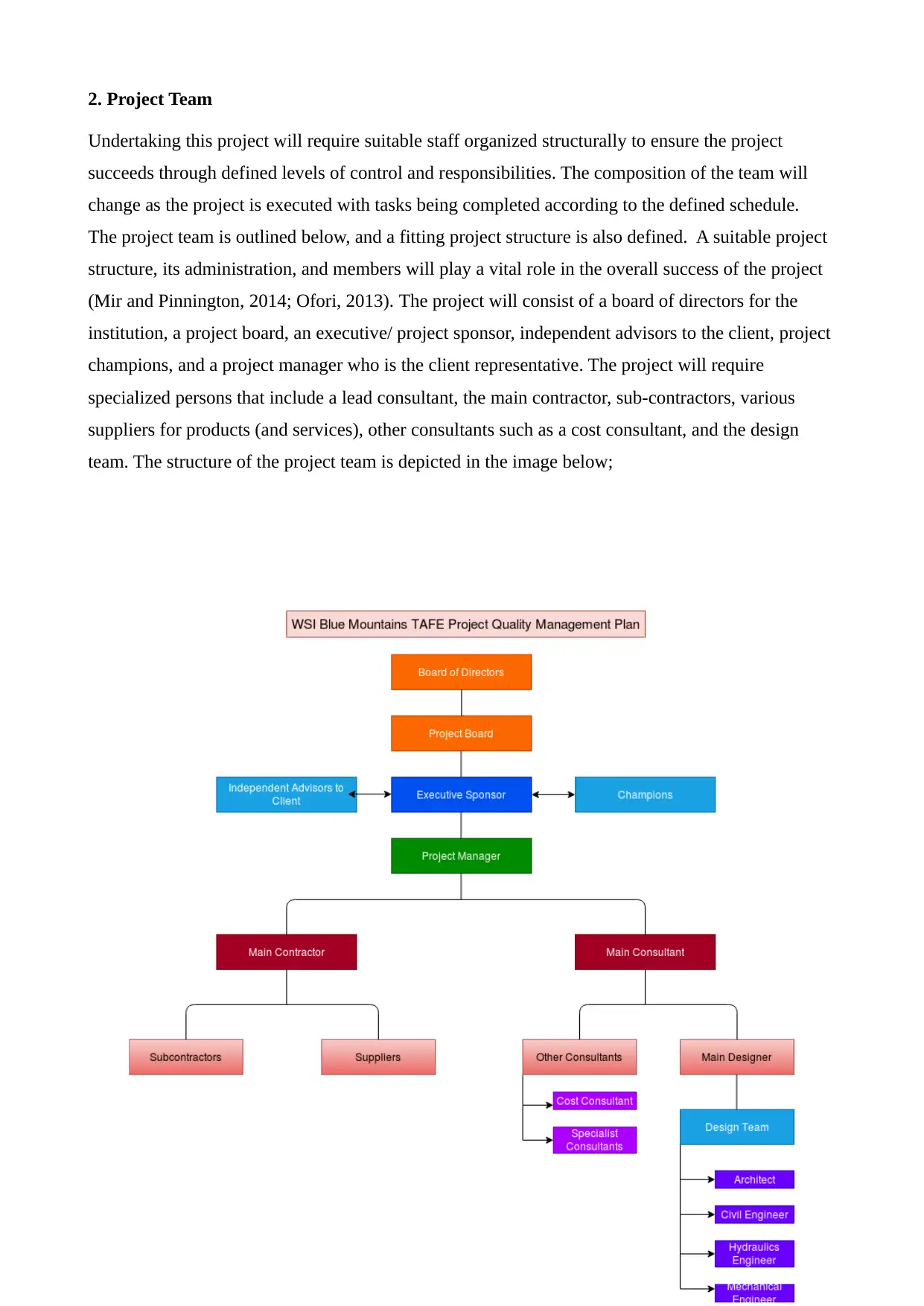
2. Project Team
Undertaking this project will require suitable staff organized structurally to ensure the project
succeeds through defined levels of control and responsibilities. The composition of the team will
change as the project is executed with tasks being completed according to the defined schedule.
The project team is outlined below, and a fitting project structure is also defined. A suitable project
structure, its administration, and members will play a vital role in the overall success of the project
(Mir and Pinnington, 2014; Ofori, 2013). The project will consist of a board of directors for the
institution, a project board, an executive/ project sponsor, independent advisors to the client, project
champions, and a project manager who is the client representative. The project will require
specialized persons that include a lead consultant, the main contractor, sub-contractors, various
suppliers for products (and services), other consultants such as a cost consultant, and the design
team. The structure of the project team is depicted in the image below;
Undertaking this project will require suitable staff organized structurally to ensure the project
succeeds through defined levels of control and responsibilities. The composition of the team will
change as the project is executed with tasks being completed according to the defined schedule.
The project team is outlined below, and a fitting project structure is also defined. A suitable project
structure, its administration, and members will play a vital role in the overall success of the project
(Mir and Pinnington, 2014; Ofori, 2013). The project will consist of a board of directors for the
institution, a project board, an executive/ project sponsor, independent advisors to the client, project
champions, and a project manager who is the client representative. The project will require
specialized persons that include a lead consultant, the main contractor, sub-contractors, various
suppliers for products (and services), other consultants such as a cost consultant, and the design
team. The structure of the project team is depicted in the image below;
Paraphrase This Document
Need a fresh take? Get an instant paraphrase of this document with our AI Paraphraser
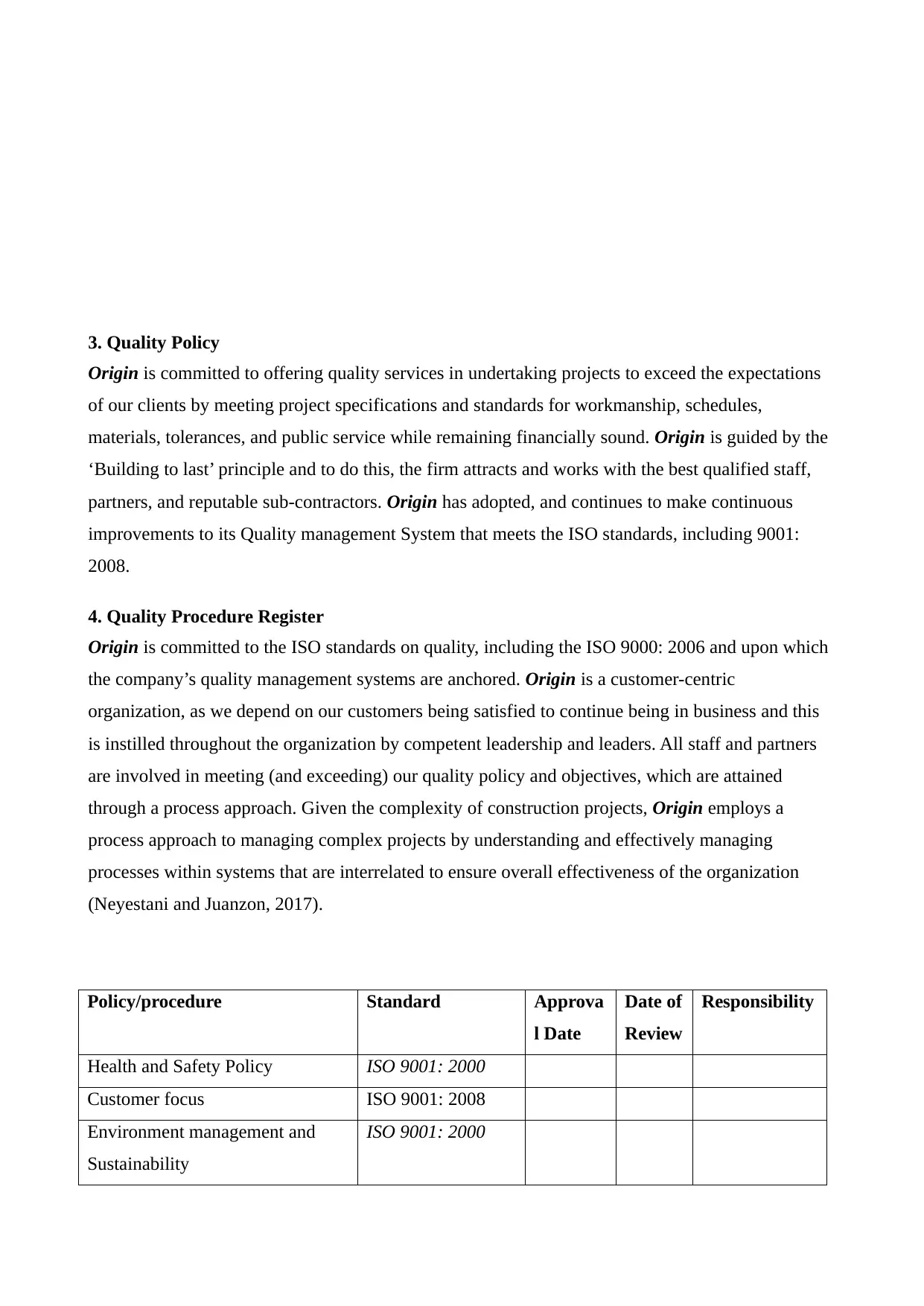
3. Quality Policy
Origin is committed to offering quality services in undertaking projects to exceed the expectations
of our clients by meeting project specifications and standards for workmanship, schedules,
materials, tolerances, and public service while remaining financially sound. Origin is guided by the
‘Building to last’ principle and to do this, the firm attracts and works with the best qualified staff,
partners, and reputable sub-contractors. Origin has adopted, and continues to make continuous
improvements to its Quality management System that meets the ISO standards, including 9001:
2008.
4. Quality Procedure Register
Origin is committed to the ISO standards on quality, including the ISO 9000: 2006 and upon which
the company’s quality management systems are anchored. Origin is a customer-centric
organization, as we depend on our customers being satisfied to continue being in business and this
is instilled throughout the organization by competent leadership and leaders. All staff and partners
are involved in meeting (and exceeding) our quality policy and objectives, which are attained
through a process approach. Given the complexity of construction projects, Origin employs a
process approach to managing complex projects by understanding and effectively managing
processes within systems that are interrelated to ensure overall effectiveness of the organization
(Neyestani and Juanzon, 2017).
Policy/procedure Standard Approva
l Date
Date of
Review
Responsibility
Health and Safety Policy ISO 9001: 2000
Customer focus ISO 9001: 2008
Environment management and
Sustainability
ISO 9001: 2000
Origin is committed to offering quality services in undertaking projects to exceed the expectations
of our clients by meeting project specifications and standards for workmanship, schedules,
materials, tolerances, and public service while remaining financially sound. Origin is guided by the
‘Building to last’ principle and to do this, the firm attracts and works with the best qualified staff,
partners, and reputable sub-contractors. Origin has adopted, and continues to make continuous
improvements to its Quality management System that meets the ISO standards, including 9001:
2008.
4. Quality Procedure Register
Origin is committed to the ISO standards on quality, including the ISO 9000: 2006 and upon which
the company’s quality management systems are anchored. Origin is a customer-centric
organization, as we depend on our customers being satisfied to continue being in business and this
is instilled throughout the organization by competent leadership and leaders. All staff and partners
are involved in meeting (and exceeding) our quality policy and objectives, which are attained
through a process approach. Given the complexity of construction projects, Origin employs a
process approach to managing complex projects by understanding and effectively managing
processes within systems that are interrelated to ensure overall effectiveness of the organization
(Neyestani and Juanzon, 2017).
Policy/procedure Standard Approva
l Date
Date of
Review
Responsibility
Health and Safety Policy ISO 9001: 2000
Customer focus ISO 9001: 2008
Environment management and
Sustainability
ISO 9001: 2000

Human resources management ISO 9004: 2009
Financial management ISO 9004: 2009
Asset management ISO 9004: 2009
Project management AS ISO 10006-
2003
Procurement and purchases 9001: 2008
Documentation and records AS ISO 10013-
2003
Verification procedure for
processes
AS ISO 10007-
2003
Verification procedure for systems AS ISO 10007-
2003
Continuous improvements ISO 9004: 2009
Appendix I: Quality Procedure Register Details
Policy/ Procedure Description
Health and Safety
Policy
Health and safety at the workplace is a primary concern to the
organization in all its endeavors and have developed a health and safety
management system that is reviewed and updated on a scheduled basis.
Before any projects, the organization undertakes an assessment of health
and safety and then develops a health and safety plan as well as safe work
procedures specific to a given project.
Customer focus The organization is selective in its selection of customers and project
types and is done strategically to meet business goals. The organization
develops and uses an estimating management system and ensures ability
to meet customer requirements. Subcontractors and suppliers are selected
based on merit and ability to meet the requirements of the organizations’
customers.
The organization understands and anticipates current and future needs of
our customers and undertakes scheduled surveys on customer satisfaction
after completion of every project and documents these.
Environment The organization has developed and maintains a corporate culture of
Financial management ISO 9004: 2009
Asset management ISO 9004: 2009
Project management AS ISO 10006-
2003
Procurement and purchases 9001: 2008
Documentation and records AS ISO 10013-
2003
Verification procedure for
processes
AS ISO 10007-
2003
Verification procedure for systems AS ISO 10007-
2003
Continuous improvements ISO 9004: 2009
Appendix I: Quality Procedure Register Details
Policy/ Procedure Description
Health and Safety
Policy
Health and safety at the workplace is a primary concern to the
organization in all its endeavors and have developed a health and safety
management system that is reviewed and updated on a scheduled basis.
Before any projects, the organization undertakes an assessment of health
and safety and then develops a health and safety plan as well as safe work
procedures specific to a given project.
Customer focus The organization is selective in its selection of customers and project
types and is done strategically to meet business goals. The organization
develops and uses an estimating management system and ensures ability
to meet customer requirements. Subcontractors and suppliers are selected
based on merit and ability to meet the requirements of the organizations’
customers.
The organization understands and anticipates current and future needs of
our customers and undertakes scheduled surveys on customer satisfaction
after completion of every project and documents these.
Environment The organization has developed and maintains a corporate culture of
⊘ This is a preview!⊘
Do you want full access?
Subscribe today to unlock all pages.

Trusted by 1+ million students worldwide
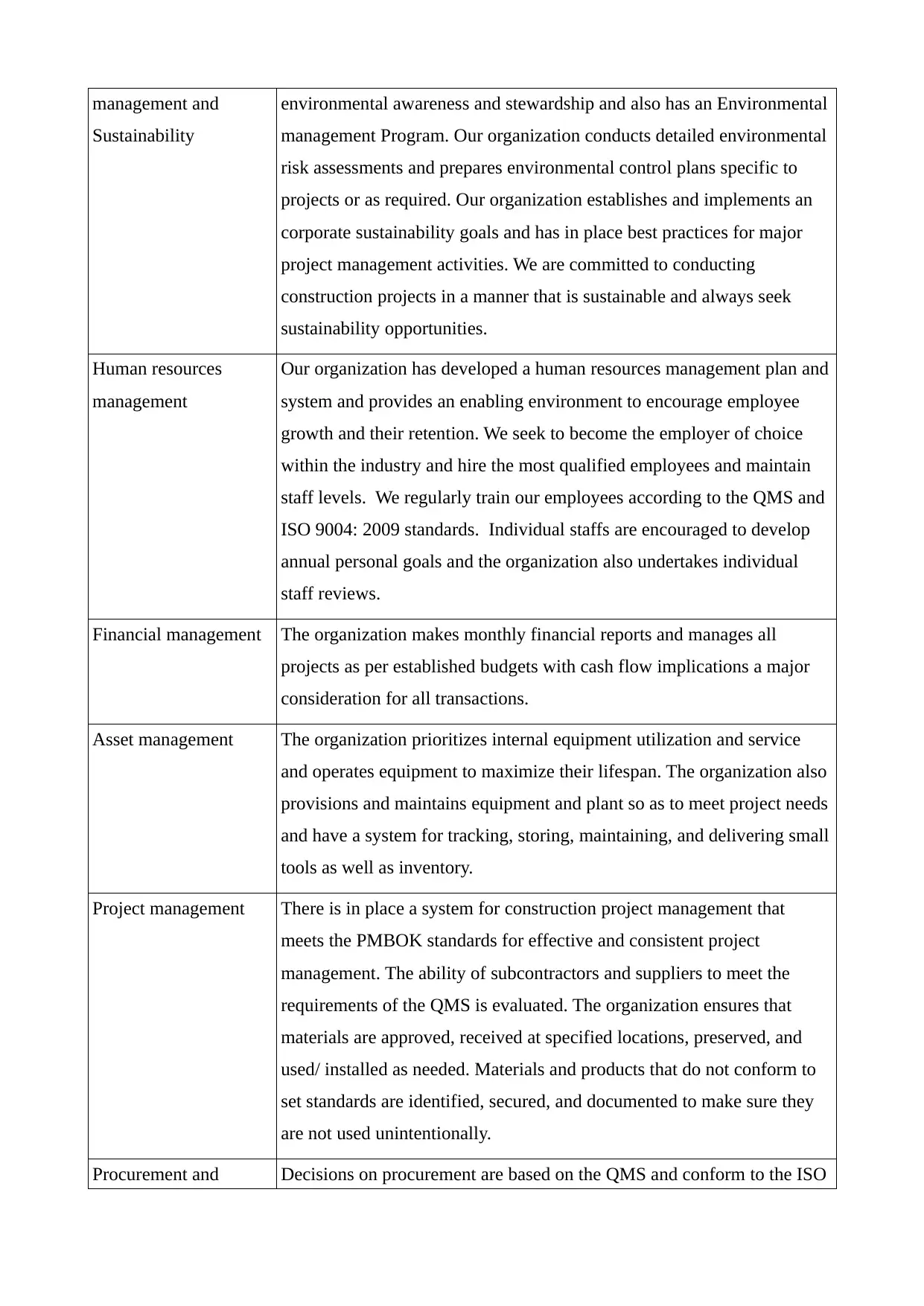
management and
Sustainability
environmental awareness and stewardship and also has an Environmental
management Program. Our organization conducts detailed environmental
risk assessments and prepares environmental control plans specific to
projects or as required. Our organization establishes and implements an
corporate sustainability goals and has in place best practices for major
project management activities. We are committed to conducting
construction projects in a manner that is sustainable and always seek
sustainability opportunities.
Human resources
management
Our organization has developed a human resources management plan and
system and provides an enabling environment to encourage employee
growth and their retention. We seek to become the employer of choice
within the industry and hire the most qualified employees and maintain
staff levels. We regularly train our employees according to the QMS and
ISO 9004: 2009 standards. Individual staffs are encouraged to develop
annual personal goals and the organization also undertakes individual
staff reviews.
Financial management The organization makes monthly financial reports and manages all
projects as per established budgets with cash flow implications a major
consideration for all transactions.
Asset management The organization prioritizes internal equipment utilization and service
and operates equipment to maximize their lifespan. The organization also
provisions and maintains equipment and plant so as to meet project needs
and have a system for tracking, storing, maintaining, and delivering small
tools as well as inventory.
Project management There is in place a system for construction project management that
meets the PMBOK standards for effective and consistent project
management. The ability of subcontractors and suppliers to meet the
requirements of the QMS is evaluated. The organization ensures that
materials are approved, received at specified locations, preserved, and
used/ installed as needed. Materials and products that do not conform to
set standards are identified, secured, and documented to make sure they
are not used unintentionally.
Procurement and Decisions on procurement are based on the QMS and conform to the ISO
Sustainability
environmental awareness and stewardship and also has an Environmental
management Program. Our organization conducts detailed environmental
risk assessments and prepares environmental control plans specific to
projects or as required. Our organization establishes and implements an
corporate sustainability goals and has in place best practices for major
project management activities. We are committed to conducting
construction projects in a manner that is sustainable and always seek
sustainability opportunities.
Human resources
management
Our organization has developed a human resources management plan and
system and provides an enabling environment to encourage employee
growth and their retention. We seek to become the employer of choice
within the industry and hire the most qualified employees and maintain
staff levels. We regularly train our employees according to the QMS and
ISO 9004: 2009 standards. Individual staffs are encouraged to develop
annual personal goals and the organization also undertakes individual
staff reviews.
Financial management The organization makes monthly financial reports and manages all
projects as per established budgets with cash flow implications a major
consideration for all transactions.
Asset management The organization prioritizes internal equipment utilization and service
and operates equipment to maximize their lifespan. The organization also
provisions and maintains equipment and plant so as to meet project needs
and have a system for tracking, storing, maintaining, and delivering small
tools as well as inventory.
Project management There is in place a system for construction project management that
meets the PMBOK standards for effective and consistent project
management. The ability of subcontractors and suppliers to meet the
requirements of the QMS is evaluated. The organization ensures that
materials are approved, received at specified locations, preserved, and
used/ installed as needed. Materials and products that do not conform to
set standards are identified, secured, and documented to make sure they
are not used unintentionally.
Procurement and Decisions on procurement are based on the QMS and conform to the ISO
Paraphrase This Document
Need a fresh take? Get an instant paraphrase of this document with our AI Paraphraser

purchases 9001: 2008 guidelines. A procurement control program is in place as well
as a system for the proper labeling, handling, packaging, delivery, and
storage of all materials and equipment. The process for procurement is
rigorous and conforms to the highest standards of quality in the industry.
Documentation and
records
This is done in conformance with AS ISO 10013-2003; a control system
for the quality policy document is in place as well as those for the work
methods, procedures manual, forms, operational policies, contract
documents, reference standards, and specifications. All confidential
records and documents are maintained in compliance with the Privacy
Laws.
Verification procedure
for processes
Is based on the AS ISO 10007-2003 standards: the organization ensures
defined contract requirements are identified and addressed adequately
during construction projects and they are reviewed fully before project
completion. Process flow charts are used in projects and have decision
points along them (the process flow charts) to verify that project
requirements are being fully met. Controlled documents are used for the
management of the process verification. All inspection, measuring, and
testing equipment used for verifying results accuracies are calibrated.
Verification procedure
for systems
The organization conducts scheduled internal audits for the QMS to make
sure it continually conforms to requirements and standards, including ISO
and Australia national Building Standards (NCC 2019: BCA).
Management Review Meetings are conducted regularly to assess internal
audit results and ensure the QMS is continually effective.
Continuous
improvements
The organization strives continuously to seek ways of improving
processes and also identifies areas of concern with a view to making
improvements by initiating corrective actions. Results identified via
statistical analyses, internal audits, customer interviews, and observations
are reviewed with a view to identifying opportunities for improvements.
4.1 Quality Management System (QMS)
Objectives
Offer exceptional reliability and service
as a system for the proper labeling, handling, packaging, delivery, and
storage of all materials and equipment. The process for procurement is
rigorous and conforms to the highest standards of quality in the industry.
Documentation and
records
This is done in conformance with AS ISO 10013-2003; a control system
for the quality policy document is in place as well as those for the work
methods, procedures manual, forms, operational policies, contract
documents, reference standards, and specifications. All confidential
records and documents are maintained in compliance with the Privacy
Laws.
Verification procedure
for processes
Is based on the AS ISO 10007-2003 standards: the organization ensures
defined contract requirements are identified and addressed adequately
during construction projects and they are reviewed fully before project
completion. Process flow charts are used in projects and have decision
points along them (the process flow charts) to verify that project
requirements are being fully met. Controlled documents are used for the
management of the process verification. All inspection, measuring, and
testing equipment used for verifying results accuracies are calibrated.
Verification procedure
for systems
The organization conducts scheduled internal audits for the QMS to make
sure it continually conforms to requirements and standards, including ISO
and Australia national Building Standards (NCC 2019: BCA).
Management Review Meetings are conducted regularly to assess internal
audit results and ensure the QMS is continually effective.
Continuous
improvements
The organization strives continuously to seek ways of improving
processes and also identifies areas of concern with a view to making
improvements by initiating corrective actions. Results identified via
statistical analyses, internal audits, customer interviews, and observations
are reviewed with a view to identifying opportunities for improvements.
4.1 Quality Management System (QMS)
Objectives
Offer exceptional reliability and service
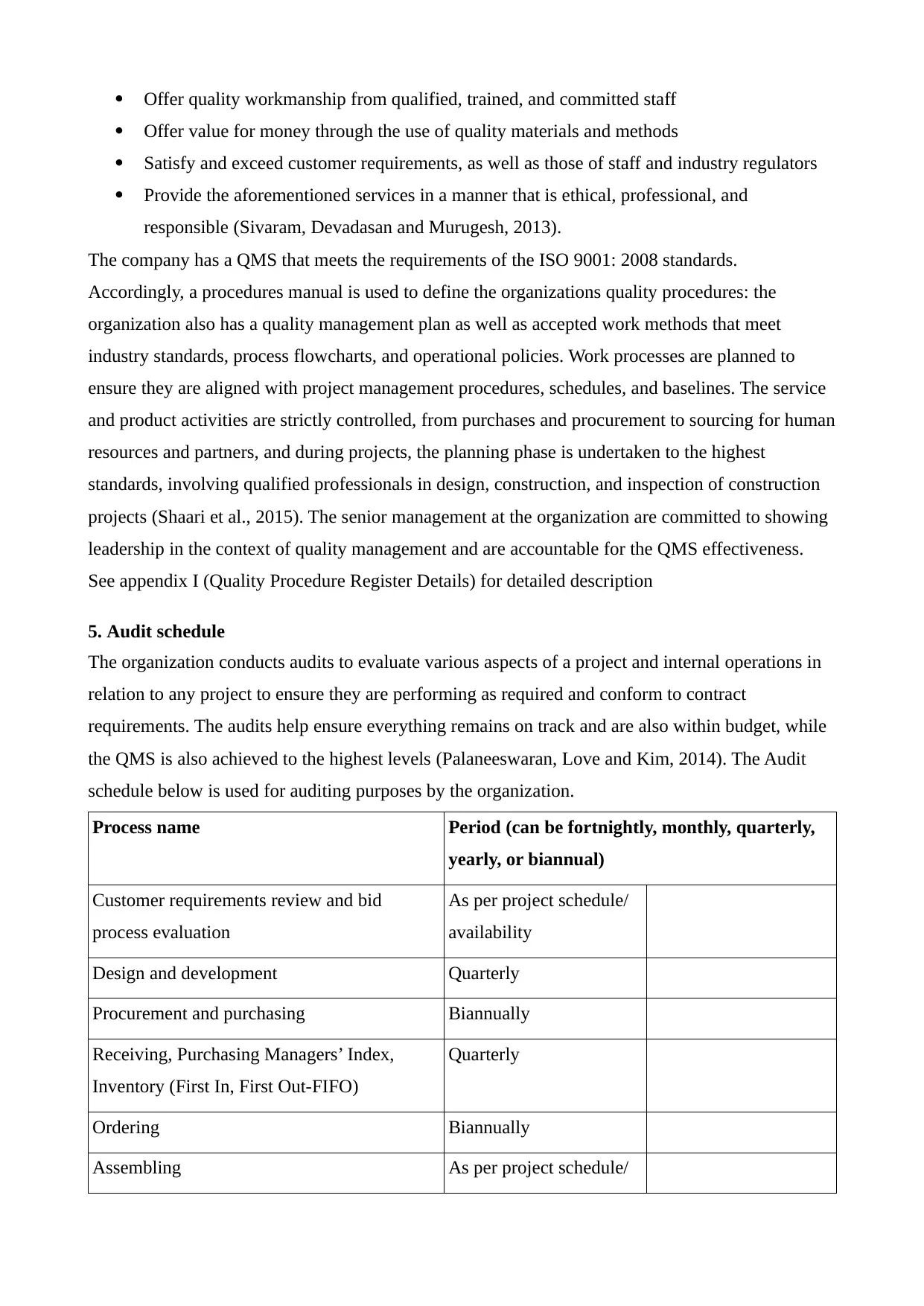
Offer quality workmanship from qualified, trained, and committed staff
Offer value for money through the use of quality materials and methods
Satisfy and exceed customer requirements, as well as those of staff and industry regulators
Provide the aforementioned services in a manner that is ethical, professional, and
responsible (Sivaram, Devadasan and Murugesh, 2013).
The company has a QMS that meets the requirements of the ISO 9001: 2008 standards.
Accordingly, a procedures manual is used to define the organizations quality procedures: the
organization also has a quality management plan as well as accepted work methods that meet
industry standards, process flowcharts, and operational policies. Work processes are planned to
ensure they are aligned with project management procedures, schedules, and baselines. The service
and product activities are strictly controlled, from purchases and procurement to sourcing for human
resources and partners, and during projects, the planning phase is undertaken to the highest
standards, involving qualified professionals in design, construction, and inspection of construction
projects (Shaari et al., 2015). The senior management at the organization are committed to showing
leadership in the context of quality management and are accountable for the QMS effectiveness.
See appendix I (Quality Procedure Register Details) for detailed description
5. Audit schedule
The organization conducts audits to evaluate various aspects of a project and internal operations in
relation to any project to ensure they are performing as required and conform to contract
requirements. The audits help ensure everything remains on track and are also within budget, while
the QMS is also achieved to the highest levels (Palaneeswaran, Love and Kim, 2014). The Audit
schedule below is used for auditing purposes by the organization.
Process name Period (can be fortnightly, monthly, quarterly,
yearly, or biannual)
Customer requirements review and bid
process evaluation
As per project schedule/
availability
Design and development Quarterly
Procurement and purchasing Biannually
Receiving, Purchasing Managers’ Index,
Inventory (First In, First Out-FIFO)
Quarterly
Ordering Biannually
Assembling As per project schedule/
Offer value for money through the use of quality materials and methods
Satisfy and exceed customer requirements, as well as those of staff and industry regulators
Provide the aforementioned services in a manner that is ethical, professional, and
responsible (Sivaram, Devadasan and Murugesh, 2013).
The company has a QMS that meets the requirements of the ISO 9001: 2008 standards.
Accordingly, a procedures manual is used to define the organizations quality procedures: the
organization also has a quality management plan as well as accepted work methods that meet
industry standards, process flowcharts, and operational policies. Work processes are planned to
ensure they are aligned with project management procedures, schedules, and baselines. The service
and product activities are strictly controlled, from purchases and procurement to sourcing for human
resources and partners, and during projects, the planning phase is undertaken to the highest
standards, involving qualified professionals in design, construction, and inspection of construction
projects (Shaari et al., 2015). The senior management at the organization are committed to showing
leadership in the context of quality management and are accountable for the QMS effectiveness.
See appendix I (Quality Procedure Register Details) for detailed description
5. Audit schedule
The organization conducts audits to evaluate various aspects of a project and internal operations in
relation to any project to ensure they are performing as required and conform to contract
requirements. The audits help ensure everything remains on track and are also within budget, while
the QMS is also achieved to the highest levels (Palaneeswaran, Love and Kim, 2014). The Audit
schedule below is used for auditing purposes by the organization.
Process name Period (can be fortnightly, monthly, quarterly,
yearly, or biannual)
Customer requirements review and bid
process evaluation
As per project schedule/
availability
Design and development Quarterly
Procurement and purchasing Biannually
Receiving, Purchasing Managers’ Index,
Inventory (First In, First Out-FIFO)
Quarterly
Ordering Biannually
Assembling As per project schedule/
⊘ This is a preview!⊘
Do you want full access?
Subscribe today to unlock all pages.

Trusted by 1+ million students worldwide
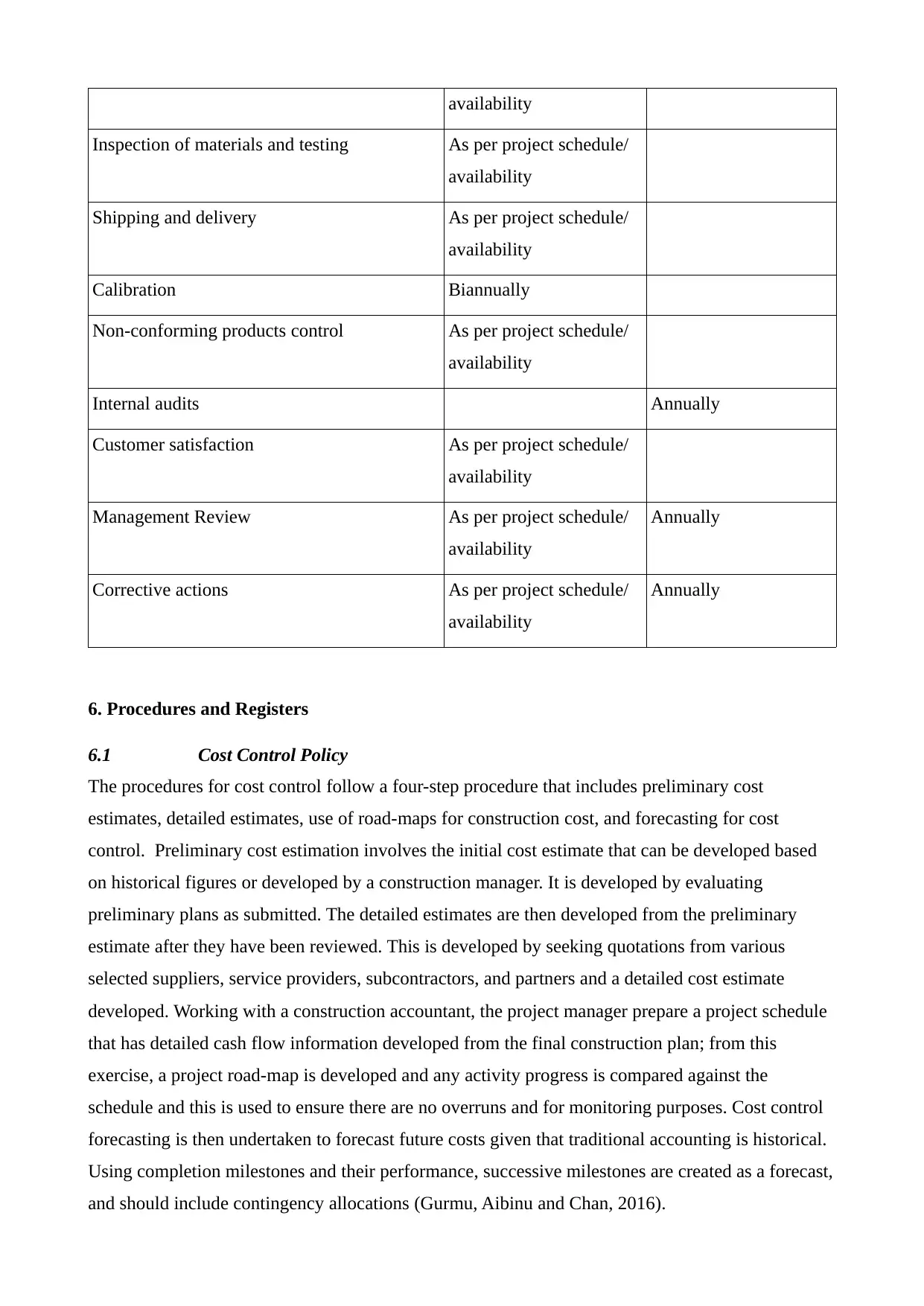
availability
Inspection of materials and testing As per project schedule/
availability
Shipping and delivery As per project schedule/
availability
Calibration Biannually
Non-conforming products control As per project schedule/
availability
Internal audits Annually
Customer satisfaction As per project schedule/
availability
Management Review As per project schedule/
availability
Annually
Corrective actions As per project schedule/
availability
Annually
6. Procedures and Registers
6.1 Cost Control Policy
The procedures for cost control follow a four-step procedure that includes preliminary cost
estimates, detailed estimates, use of road-maps for construction cost, and forecasting for cost
control. Preliminary cost estimation involves the initial cost estimate that can be developed based
on historical figures or developed by a construction manager. It is developed by evaluating
preliminary plans as submitted. The detailed estimates are then developed from the preliminary
estimate after they have been reviewed. This is developed by seeking quotations from various
selected suppliers, service providers, subcontractors, and partners and a detailed cost estimate
developed. Working with a construction accountant, the project manager prepare a project schedule
that has detailed cash flow information developed from the final construction plan; from this
exercise, a project road-map is developed and any activity progress is compared against the
schedule and this is used to ensure there are no overruns and for monitoring purposes. Cost control
forecasting is then undertaken to forecast future costs given that traditional accounting is historical.
Using completion milestones and their performance, successive milestones are created as a forecast,
and should include contingency allocations (Gurmu, Aibinu and Chan, 2016).
Inspection of materials and testing As per project schedule/
availability
Shipping and delivery As per project schedule/
availability
Calibration Biannually
Non-conforming products control As per project schedule/
availability
Internal audits Annually
Customer satisfaction As per project schedule/
availability
Management Review As per project schedule/
availability
Annually
Corrective actions As per project schedule/
availability
Annually
6. Procedures and Registers
6.1 Cost Control Policy
The procedures for cost control follow a four-step procedure that includes preliminary cost
estimates, detailed estimates, use of road-maps for construction cost, and forecasting for cost
control. Preliminary cost estimation involves the initial cost estimate that can be developed based
on historical figures or developed by a construction manager. It is developed by evaluating
preliminary plans as submitted. The detailed estimates are then developed from the preliminary
estimate after they have been reviewed. This is developed by seeking quotations from various
selected suppliers, service providers, subcontractors, and partners and a detailed cost estimate
developed. Working with a construction accountant, the project manager prepare a project schedule
that has detailed cash flow information developed from the final construction plan; from this
exercise, a project road-map is developed and any activity progress is compared against the
schedule and this is used to ensure there are no overruns and for monitoring purposes. Cost control
forecasting is then undertaken to forecast future costs given that traditional accounting is historical.
Using completion milestones and their performance, successive milestones are created as a forecast,
and should include contingency allocations (Gurmu, Aibinu and Chan, 2016).
Paraphrase This Document
Need a fresh take? Get an instant paraphrase of this document with our AI Paraphraser

6.2 Client Variation Register
This is developed to create a link between project change management documents to the external
contract (legal agreement). A contract variation represents a legal agreement and it controls contract
variation issues as well as keeping track of the cost of these variations to the project (El Yamami et
al., 2018). – See Appendix II: - Contract Variation Register
6.3 Subcontractor Variation Register
This is an alteration of a project scope of works initiated by, or involving any
Subcontractors involved in the project (Cao and Wang, 2014). The register below is used for the
management and recording or all variations related to subcontractors. – See Appendix I-
Subcontractor Variation Register
6.4 Document Control Policy
A document flow diagram for each document and its movement within the organization will be
created for the project. The flow diagram indicates the origin of each document, people interacting
with the document, the final destination, and where it is archived. The documents are then created
based on purpose and are standardized. Documents will have a version control feature, date of
creation, creator, and any approval requirements incorporated (Harned, 2020). Each document will
be created as a digital document, with the ability to have them printed. Each document that is
changed will have its version number changed with the dates automatically updated. All documents
will be archived electronically in a manner that is retrievable and physical documents will also be
stored in a filing system. The documents will be kept / stored for a minimum of seven years, and
afterwards, the physical documents will be discarded by shredding. Electronic documents will be
archived indefinitely in a cloud storage database for any future reference or use.
6.5 Drawing Control Policy
The drawings will be controlled using suitable software; in line with the organizations’ quality
policy and desire for customer satisfaction, the drawings and design for the entire project and its
attendant features will be managed through a building Information Modeling (BIM) application.
This will ensure that all different aspects of the project are controlled and remain interconnected, for
the civil, structural, electrical, hydrological, and mechanical works. Further, this will form the basis
for lifetime management of the facility and ensure energy efficiency and accurate and effective
management of changes (Xu, Ma and Ding, 2014). Through BIM software, any change in one
component will automatically show how this affects other components and adjustments for the
whole structure and project made as a result. It will also help with managing alterations.
This is developed to create a link between project change management documents to the external
contract (legal agreement). A contract variation represents a legal agreement and it controls contract
variation issues as well as keeping track of the cost of these variations to the project (El Yamami et
al., 2018). – See Appendix II: - Contract Variation Register
6.3 Subcontractor Variation Register
This is an alteration of a project scope of works initiated by, or involving any
Subcontractors involved in the project (Cao and Wang, 2014). The register below is used for the
management and recording or all variations related to subcontractors. – See Appendix I-
Subcontractor Variation Register
6.4 Document Control Policy
A document flow diagram for each document and its movement within the organization will be
created for the project. The flow diagram indicates the origin of each document, people interacting
with the document, the final destination, and where it is archived. The documents are then created
based on purpose and are standardized. Documents will have a version control feature, date of
creation, creator, and any approval requirements incorporated (Harned, 2020). Each document will
be created as a digital document, with the ability to have them printed. Each document that is
changed will have its version number changed with the dates automatically updated. All documents
will be archived electronically in a manner that is retrievable and physical documents will also be
stored in a filing system. The documents will be kept / stored for a minimum of seven years, and
afterwards, the physical documents will be discarded by shredding. Electronic documents will be
archived indefinitely in a cloud storage database for any future reference or use.
6.5 Drawing Control Policy
The drawings will be controlled using suitable software; in line with the organizations’ quality
policy and desire for customer satisfaction, the drawings and design for the entire project and its
attendant features will be managed through a building Information Modeling (BIM) application.
This will ensure that all different aspects of the project are controlled and remain interconnected, for
the civil, structural, electrical, hydrological, and mechanical works. Further, this will form the basis
for lifetime management of the facility and ensure energy efficiency and accurate and effective
management of changes (Xu, Ma and Ding, 2014). Through BIM software, any change in one
component will automatically show how this affects other components and adjustments for the
whole structure and project made as a result. It will also help with managing alterations.
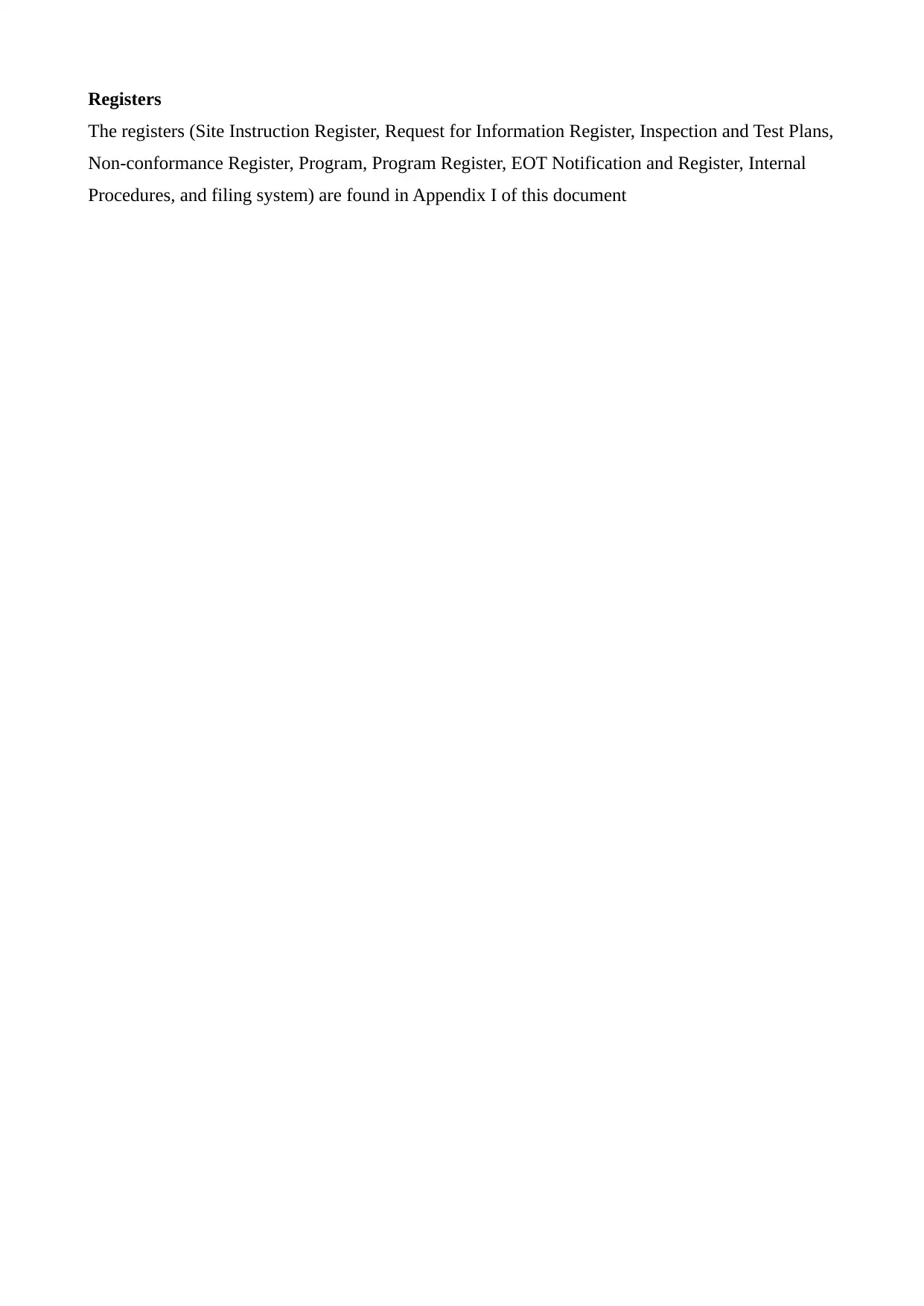
Registers
The registers (Site Instruction Register, Request for Information Register, Inspection and Test Plans,
Non-conformance Register, Program, Program Register, EOT Notification and Register, Internal
Procedures, and filing system) are found in Appendix I of this document
The registers (Site Instruction Register, Request for Information Register, Inspection and Test Plans,
Non-conformance Register, Program, Program Register, EOT Notification and Register, Internal
Procedures, and filing system) are found in Appendix I of this document
⊘ This is a preview!⊘
Do you want full access?
Subscribe today to unlock all pages.

Trusted by 1+ million students worldwide
1 out of 22
Related Documents
Your All-in-One AI-Powered Toolkit for Academic Success.
+13062052269
info@desklib.com
Available 24*7 on WhatsApp / Email
![[object Object]](/_next/static/media/star-bottom.7253800d.svg)
Unlock your academic potential
Copyright © 2020–2025 A2Z Services. All Rights Reserved. Developed and managed by ZUCOL.





